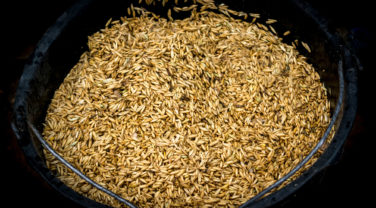Understanding Energy in your Horse’s Diet
The Dengie feedline receives lots of calls from horse owners who would like their horse to have more energy or less energy. Diet can clearly have a significant impact on the energy levels of many horses, but owners are often uncertain what alterations to make to the ration to achieve the desired effect. Understanding where energy comes from is the first step to getting a forward-going but controlled horse.
What is energy?
Energy is technically not a nutrient, but is released when food is broken down. Two measurements are used: calorie is the ‘old money’ term and joule is the decimal system. We all tend to think of calories as the measure of how fattening a feed is – not many of us talk about a ‘joule-controlled diet’ – but both measure the same thing, just as miles and kilometres both measure distance.
Types of energy in horse feed
Carbohydrates are the main source of energy for the horse and come from fibre, starch and sugars. The most abundant carbohydrate is cellulose, which makes up between 20 and 40% of the dry matter of plants.
Cellulose consists of glucose molecules linked together in a way that digestive enzymes in mammals – including horses and humans – are unable to break down. Herbivores rely on bacteria and other microbes to break down fibre to release energy, which the host animal can then utilise.
Their digestive systems have developed areas, such as the caecum in the horse, that slow the speed with which food travels through the digestive system long enough to allow microbes sufficient time to break the fibre down. Very indigestible material can take up to three days to pass through the horse’s digestive tract to try to maximise the amount of energy obtained from it. Some material will escape digestion, so not all the energy contained within a feed will be utilised.
Starch is also made up of glucose, but the molecules are joined together in such a way that the animal’s own digestive enzymes can break them down to release the energy. This happens in the fore gut, so releases the energy more quickly than fibre, and this is why cereals, which contain lots of starch, provide the horse with quick-release energy relative to fibre.
Sugar receives a lot of bad press, but it is important to recognise that the horse has evolved on a diet that contains relatively high levels of sugar at certain times of the year. The main source of sugar in the horse’s diet is grass, particularly fresh pasture. Water-soluble carbohydrates is another name for sugars and indicates why soaking hay can remove some of the sugar it contains.
Energy is also present in fats and oils, and considered a slow-release energy source. Fats and oils are energy-dense, containing 2.25 times more energy than carbohydrates, so feeds with a high oil content can be very conditioning. The type of fatty acids that make up the oil dictate its quality. Because omega-3 and 6 fatty acids are essential (must be supplied in the diet), oils that are high in these are considered high-quality.
Where does the horse get energy from?
The main types of energy for horses at grass are sugar and fibre. The oil content of grass is very low, but higher in omega-3 than 6. Cereals are commonly used to supply working horses with more energy, but at Dengie, as you probably know, we try to keep the use of starch to a minimum because of the negative effects it can have on health and behaviour. Not all fibre sources contain the same levels of energy. For example, Alfa-A Original contains the same amount of energy as a cool mix and, if fed at the same levels, provides the same amount of energy. Adding oil increases the energy content even further without having to increase starch intake. Alfa-A Oil, for example, contains the same level of energy as a conditioning mix.
Giving your horse more or less energy
Energy metabolism involves other nutrients, so whenever owners wants their horses to have more energy, the starting point is to ensure the diet is balanced. It is also important to make sure that the horse isn’t being asked to work above its level of fitness and ability. Assuming that the level of energy is also sufficient for the work the horse is doing, it is then a case of introducing some cereals that will supply quick-release energy. These should be introduced gradually and increased slowly to see whether they have an effect on the horse’s energy levels. Sometimes, whatever you feed, the horse just isn’t going to change and, if no effect is found, it is advisable to remove the cereals from the diet.
For horses that are over-excitable, the energy supply should come from fibre and oil. Using highly digestible fibre sources such as alfalfa and sugar beet will supply lots of slow-release energy. For additional energy to support work or promote weight gain, oil can be added. A combination of high-quality fibre and oil can provide enough energy for horses working at the highest levels, so there is no need to use cereals at all, which should help to create a less excitable horse. Our case study: Maintaining Condition without Fizz, gives a further insight into how to maintain your horses’ condition with a less energy-based diet.
As always, if you have any questions or feedback about this article, we would love to hear from you.



